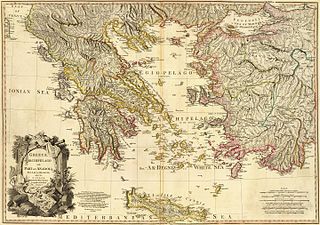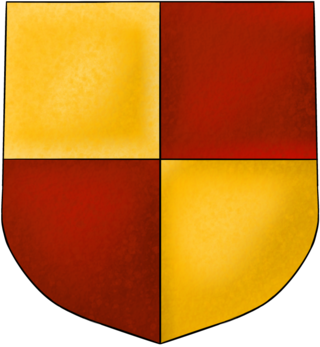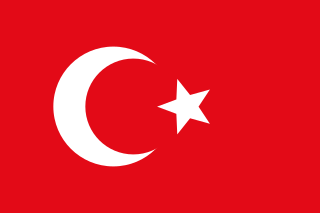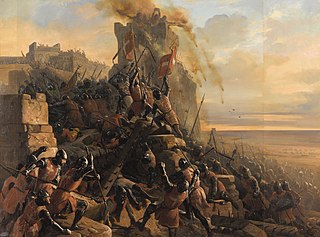
Chios is the fifth largest Greek island, situated in the northern Aegean Sea, and the tenth largest island in the Mediterranean Sea. The island is separated from Turkey by the Chios Strait. Chios is notable for its exports of mastic gum and its nickname is "the Mastic Island". Tourist attractions include its medieval villages and the 11th-century monastery of Nea Moni, a UNESCO World Heritage Site.

The Republic of Genoa was a medieval and early modern maritime republic from the years 1099 to 1797 in Liguria on the northwestern Italian coast. During the Late Middle Ages, it was a major commercial power in both the Mediterranean and Black Sea. Between the 16th and 17th centuries, it was one of the major financial centres in Europe.
Leonard of Chios was a Greek scholar of the Dominican Order and Latin Archbishop of Mytilene, best known for his eye-witness account of the Fall of Constantinople in 1453, which is one of the main sources for the event.

Genoa, Italy, has historically been one of the most important ports on the Mediterranean.

Maona of Chios and Phocaea was a maona formed to exact taxes for the Republic of Genoa from the island of Chios and port of Phocaea. Genoa sold the rights to their taxes to the maona, which raised funds from its investors to buy galleys and eventually re-conquer Chios and Phocaea.

The Lordship of Chios was a short-lived autonomous lordship run by the Genoese Zaccaria family. Its core was the eastern Aegean island of Chios, and in its height it encompassed a number of other islands off the shore of Asia Minor. Although theoretically a vassal of the Byzantine Empire, the Zaccaria ruled the island as a practically independent domain from its capture in 1304 until the Greek-Byzantines recovered it, with the support of the local Greek population, in 1329. The island would return to Genoese control in 1346 under the Maona of Chios and Phocaea.

The history of Corsica in the medieval period begins with the collapse of the Western Roman Empire and the invasions of various Germanic peoples in the fifth century AD, and ends with the complete subjection of the island to the authority of the Bank of San Giorgio in 1511.

The Venetian–Genoese Wars were four conflicts between the Republic of Venice and the Republic of Genoa which took place between 1256 and 1381. Each was resolved almost entirely through naval clashes, and they were connected to each other by interludes during which episodes of piracy and violence between the two Italian trading communities in the Mediterranean Sea and the Black Sea were commonplace, in a "cold war" climate.

The Frankokratia, also known as Latinokratia and, for the Venetian domains, Venetokratia or Enetokratia, was the period in Greek history after the Fourth Crusade (1204), when a number of primarily French and Italian states were established by the Partitio terrarum imperii Romaniae on the territory of the dismantled Byzantine Empire.

The Zaccaria family is an ancient and noble Genoese House that had great importance in the development and consolidation of the Republic of Genoa in the thirteenth and fourteenth centuries, and whose only surviving branch produced the last ruling dynasty of the Principality of Achaea.

Genoese Gibraltarians have existed in Gibraltar since the 16th century and later became an important part of the population. It is an ethnic community made up of descendants of Genoese and Ligurians who emigrated to Gibraltar during the Italian diaspora. The population of Gibraltar with Genoese surnames is around 20% of the total.

The Genoesecolonies were a series of economic and trade posts in the Mediterranean and Black Seas. Some of them had been established directly under the patronage of the republican authorities to support the economy of the local merchants, while others originated as feudal possessions of Genoese nobles, or had been founded by powerful private institutions, such as the Bank of Saint George.

Giovanni di Murta was the second Doge of Genoa following the resignation of Simone Boccanegra, on 25 December 1345. His dogate was dominated by his attempts to break the circle of political violence which had crippled the city over the past century and to reassert Genoese dominion over the Mediterranean colonies.
Arrigo Della Rocca was a nobleman who dominated the political life of Corsica during the second half of the 14th century. Partisan of an aristocratic regime, he was supported by the Crown of Aragon and opposed by the plebeians and the Republic of Genoa.

Nicolò Guarco was a Genoese statesman who became the 7th doge of the Republic of Genoa and led the Republic through the War of Chioggia against Venice.

Giacomo Fregoso or Campofregoso (1340–1420) was a statesman who became the 10th doge of Genoa.

The Sanjak of Sakız or Chios was a second-level Ottoman province centred on the eastern Aegean island of Chios. Its Turkish name, Sakız, derived from the island's most distinctive product, gum mastic.

The Hospitaller conquest of Rhodes took place in 1306–1310. The Knights Hospitaller, led by Grand Master Foulques de Villaret, landed on the island in summer 1306 and quickly conquered most of it except for the city of Rhodes, which remained in Byzantine hands. Emperor Andronikos II Palaiologos sent reinforcements, which allowed the city to repel the initial Hospitaller attacks, and persevere until it was captured on 15 August 1310. The Hospitallers transferred their base to the island, which became the centre of their activities until it was conquered by the Ottoman Empire in 1522.
Andreolo Giustiniani was an antiquarian, humanist, literary patron, and writer of the Italian Renaissance.
Simone Vignoso was a 14th-century Genoese admiral. In 1346 he led a fleet that conquered the island of Chios and the port of Phocaea, establishing the Genoese-run Maona of Chios and Phocaea company there. Nothing is known of him after 1350.












